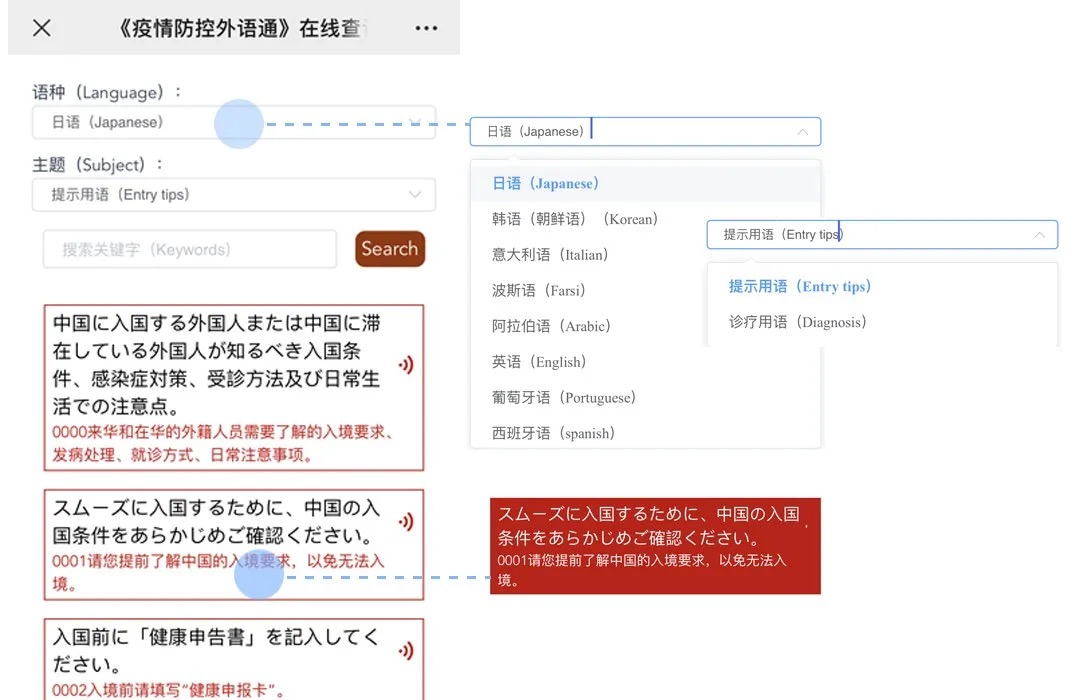In order to help international students and foreign nationals in China get timely information about COVID-19 epidemic and reduce communication barrier, the Language Service Team for the fight against the epidemic, under the guidance and support of the Ministry of Education and the State Language Commission, has developed “A Guide to the Prevention and Control of COVID-19 Epidemic in Foreign Languages—Daily Precautions”, “A Guide to the Prevention and Control of COVID-19 Epidemic in Foreign Languages—Entry Tips”, “A Guide to the Prevention and Control of COVID-19 Epidemic in Foreign Languages—Diagnosis” and “A Guide to the Prevention and Control of COVID-19 Epidemic in Foreign Languages—Protection Measures” in multiple languages. These languages include Arabic, Amharic, Azerbaijani, Persian, German, Russian, French, Korean, Hausa, Catalan, Cambodian, Lao, Mongolian, Malay, Portuguese, Japanese, Swahili, Thai, Turkish, Spanish, Greek, Italian, English, Indonesian, Vietnamese and so on. The guide selected 75 commonly-used sentences, related to protective measures, diagnosis, and entry tips, from official documents—Plan for Prevention and Control of the COVID-19, Plan for Diagnosis and Treatment of the COVID-19, and Guidance for Public Prevention on the COVID-19, released by the National Health Commission. They have been released on the WeChat official account and the official website of ACLR of BLCU in the forms of micro videos and online enquiry systems. In addition, they will be disseminated through different channels. In this way, we contribute our efforts to prevent and control the epidemic on a global scale.
We hope that people in the world unite to win the ultimate victory against the epidemic soon!
A Guide to the Prevention and Control of COVID-19 Epidemic in Foreign Languages(mobile and Web versions)
A Guide to the Prevention and Control of COVID-19 Epidemic in Foreign Languages


A Guide to the Prevention and Control of COVID-19 Epidemic in Foreign Languages (Web version)

http://yuyanziyuan.net:9505/
Background Introduction
At present, while the COVID-19 epidemic in China is under control, that in foreign countries is getting worse. Under the guidance and support of the Ministry of Education and the State Language Commission, ACLR, which forms the Language Service Team for the fight against the epidemic, has emergently developed “A Guide to the Prevention and Control of COVID-19 Epidemic in Foreign Languages”, providing language services for international students and foreign nationals in China with COVID-19 epidemic prevention, control and diagnosis information. The Guide selected 75 commonly-used sentences related to protective measures, diagnosis, and entry tips, from official documents ̶ Plan for Prevention and Control of the COVID-19, Plan for Diagnosis and Treatment of the COVID-19, and Guidance for Public Prevention on the COVID-19, released by the National Health Commission. The Guide has been translated into multiple languages including Arabic, Amharic, Azerbaijani, Persian, German, Russian, French, Korean, Hausa, Catalan, Cambodian, Lao, Mongolian, Malay, Portuguese, Japanese, Swahili, Thai, Turkish, Spanish, Greek, Italian, English, Indonesian, Vietnamese and so on. Multilingual micro videos, electronic cards and online enquiry systems have been made based on the Guide. Parts of them have been released through the WeChat official account of ACLR in succession since 2nd March. They will also be released through channels such as social platforms, websites, television, broadcasts, and press.
The contents of the Guide can be flexibly combined for different needs. Apart from for international students and foreign nationals, they can be used by medical institutions, educational institutions, airports, ports, airlines, foreign affairs agencies, customs, and community management offices.
We will continue to enrich the contents of the Guide and translate it into more languages. In this way, we contribute our efforts to prevent and control the epidemic at home and share China’s experience in fighting against the epidemic.